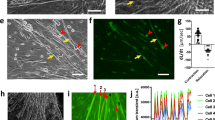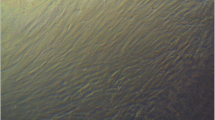Abstract
Adipose tissue-derived stromal cells (ADSCs) can differentiate into cardiomyocytes, which provide a source of new cardiomyocyte progenitors for tissue engineering. Here, we showed that ADSCs isolated from subcutaneous adipose tissues of mouse were largely negative for CD31, CD34, but positive for CD105. About 1.62% cells in these cells can spontaneously differentiate into cardiac-like cells (cells expressing cardiac marker proteins) when cultured in Dulbecco’s modified Eagle’s medium (DMEM) supplemented only with penicillin, streptomycin, and 20% newborn bovine serum (NBS), expressed cardiac markers such as MF20, Connexin45, cMHC, cTnT, a-actin, Nkx2.5, and GATA4, and part of these cells (account for about 0.47% of inoculated cells) showed spontaneous contractions accompanied by transient Ca2+ activity in culture. In vitro, although over-expression of Nkx2.5 and/or cardiac α-actin increased the number of cardiac-like cells expressing cardiac-specific proteins, but while inhibited the contraction function of ADSCs-derived cardiomyocytes.






Similar content being viewed by others
References
Vidarsson H, Hyllner J, Sartipy P (2010) Differentiation of human embryonic stem cells to cardiomyocytes for in vitro and in vivo applications. Stem Cell Rev Rep 6:108–120
Beltrami AP, Barlucchi L, Torella D, Baker M, Limana F, Chimenti S, Kasahara H, Rota M, Musso E, Urbanek K, Leri A, Kajstura J, Nadal-Ginard B, Anversa P (2003) Adult cardiac stem cells are multipotent and support myocardial regeneration. Cell 114:763–776
Pallante BA, Duignan I, Okin D, Chin A, Bressan MC, Mikawa T, Edelberg JM (2007) Bone marrow Oct3/4+ cells differentiate into cardiac myocytes via age-dependent paracrine mechanisms. Circ Res 100:1–11
Oyama T, Nagai T, Wada H, Naito AT, Matsuura K, Iwanaga K, Takahashi T, Goto M, Mikami Y, Yasuda N, Akazawa H, Uezumi A, Takeda S, Komuro I (2007) Cardiac side population cells have a potential to migrate and differentiate into cardiomyocytes in vitro and in vivo. J Cell Biol 176:329–341
Zhang J, Wilson GF, Soerens AG, Koonce CH, Yu J, Palecek SP, Thomson JA, Kamp TJ (2009) Functional cardiomyocytes derived from human induced pluripotent stem cells. Circ Res 104:30–41
Madonna R, Geng YJ, De Caterina R (2009) Adipose tissue-derived stem cells: characterization and potential for cardiovascular repair. Arterioscler Thromb Vasc Biol 29:1723–1729
Léobon B, Roncalli J, Joffre C, Mazo M, Boisson M, Barreau C, Calise D, Arnaud E, André M, Pucéat M, Pénicaud L, Prosper F, Planat-Bénard V, Casteilla L (2009) Adipose-derived cardiomyogenic cells: in vitro expansion and functional improvement in a mouse model of myocardial infarction. Cardiovasc Res 83:757–767
Zuk PA, Zhu M, Mizuno H, Huang J, Futrell JW, Katz AJ, Benhaim P, Lorenz HP, Hedrick MH (2001) Multilineage cells from human adipose tissue: implications for cell-based therapies. Tissue Eng 7:211–228
Bacou F, el Andalousi RB, Daussin PA, Micallef JP, Levin JM, Chammas M, Casteilla L, Reyne Y, Nouguès J (2004) Transplantation of adipose tissue-derived stromal cells increases mass and functional capacity of damaged skeletal muscle. Cell Transplant 13:103–111
Planat-Bénard V, Menard C, André M, Puceat M, Perez A, Garcia-Verdugo JM, Pénicaud L, Casteilla L (2004) Spontaneous cardiomyocyte differentiation from adipose tissue stroma cells. Circ Res 94:223–229
Kim MR, Jeon ES, Kim YM, Lee JS, Kim JH (2009) Thromboxane A2 induces differentiation of human mesenchymal stem cells to smooth muscle-like cells. Stem Cells 27:191–199
Erickson GR, Gimble JM, Franklin DM, Rice HE, Awad H, Guilak F (2002) Chondrogenic potential of adipose tissue-derived stromal cells in vitro and in vivo. Biochem Biophys Res Commun 290:763–769
Gimble J, Guilak F (2003) Adipose-derived adult stem cells: isolation, characterization, and differentiation potential. Cytotherapy 5:362–369
Rangappa S, Fen C, Lee EH, Bongso A, Sim EK (2003) Transformation of adult mesenchymal stem cells isolated from the fatty tissue into cardiomyocytes. Ann Thorac Surg 75:775–779
Choi YS, Dusting GJ, Stubbs S, Arunothayaraj S, Han XL, Collas P, Morrison WA, Dilley RJ (2010) Differentiation of human adipose-derived stem cells into beating cardiomyocytes. J Cell Mol Med 14:878–889
Jumabay M, Zhang R, Yao Y, Goldhaber JI, Boström KI (2010) Spontaneously beating cardiomyocytes derived from white mature adipocytes. Cardiovasc Res 85:17–27
Matsumoto T, Kano K, Kondo D, Fukuda N, Iribe Y, Tanaka N, Matsubara Y, Sakuma T, Satomi A, Otaki M, Ryu J, Mugishima H (2007) Mature adipocyte-derived dedifferentiated fat cells exhibit multilineage potential. J Cell Physiol 215:210–222
Kazama T, Fujie M, Endo T, Kano K (2008) Mature adipocyte-derived dedifferentiated fat cells can transdifferentiate into skeletal myocytes in vitro. Biochem Biophys Res Commun 377:780–785
Briggs LE, Takeda M, Cuadra AE, Wakimoto H, Marks MH, Walker AJ, Seki T, Oh SP, Lu JT, Sumners C, Raizada MK, Horikoshi N, Weinberg EO, Yasui K, Ikeda Y, Chien KR, Kasahara H (2008) Perinatal loss of Nkx2-5 results in rapid conduction and contraction defects. Circ Res 103:580–590
Yamada Y, Sakurada K, Takeda Y, Gojo S, Umezawa A (2007) Single-cell-derived mesenchymal stem cells overexpressing Csx/Nkx2.5 and GATA4 undergo the stochastic cardiomyogenic fate and behave like transient amplifying cells. Exp Cell Res 313:698–706
Sassoon DA, Garner I, Buckingham M (1988) Transcripts of α-cardiac and α-skeletal actins are early markers for myogenesis in the mouse embryo. Development 104:155–164
Chen CY, Schwartz RJ (1996) Recruitment of the tinman homolog Nkx-2.5 by serum response factor activates cardiac a-actin gene transcription. Mol Cell Biol 16:6372–6384
Tholpady SS, Katz AJ, Ogle RC (2003) Mesenchymal stem cells from rat visceral fat exhibit multipotential differentiation in vitro. Anat Rec A Discov Mol Cell Evol Biol 272:398–402
Madonna R, De Caterina R (2008) In vitro neovasculogenic potential of resident adipose tissue precursors. Am J Physiol Cell Physiol 295:1271–1280
He TC, Zhou S, da Costa LT, Yu J, Kinzler KW, Vogelstein B (1998) A simplified system for generating recombinant adenoviruses. Proc Natl Acad Sci USA 95:2509–2514
Dubois SG, Floyd EZ, Zvonic S, Kilroy G, Wu X, Carling S, Halvorsen YD, Ravussin E, Gimble JM (2008) Isolation of human adipose-derived stem cells from biopsies and liposuction specimens. Methods Mol Biol 449:69–79
Kodama H, Hirotani T, Suzuki Y, Ogawa S, Yamazaki K (2002) Cardiomyogenic differentiation in cardiac myxoma expressing lineage-specific transcription factors. Am J Pathol 161:381–389
Armiñán A, Gandía C, Bartual M, García-Verdugo JM, Lledó E, Mirabet V, Llop M, Barea J, Montero JA, Sepúlveda P (2009) Cardiac differentiation is driven by NKX2.5 and GATA4 nuclear translocation in tissue-specific mesenchymal stem cells. Stem Cells Dev 18:907–918
Skerjanc IS, Petropoulos H, Ridgeway AG, Wilton S (1998) Myocyte enhancer factor 2C and Nkx2-5 up-regulate each other’s expression and initiate cardiomyogenesis in P19 cells. J Biol Chem 273:34904–34910
Wei L, Roberts W, Wang L, Yamada M, Zhang S, Zhao Z, Rivkees SA, Schwartz RJ, Imanaka-Yoshida K (2001) Rho kinases play an obligatory role in vertebrate embryonic organogenesis. Development 128:2953–2962
Yamada Y, Yokoyama S, Wang XD, Fukuda N, Takakura N (2007) Cardiac stem cells in brown adipose tissue express CD133 and induce bone marrow nonhematopoietic cells to differentiate into cardiomyocytes. Stem Cells 25:1326–1333
Monzen K, Zhu W, Kasai H, Hiroi Y, Hosoda T, Akazawa H, Zou Y, Hayashi D, Yamazaki T, Nagai R, Komuro I (2002) Dual effects of the homeobox transcription factor Csx/Nkx2-5 on cardiomyocytes. Biochem Biophys Res Commun 298:493–500
Riazi AM, Lee H, Hsu C, Van Arsdell G (2005) CSX/Nkx2.5 modulates differentiation of skeletal myoblasts and promotes differentiation into neuronal cells in vitro. J Biol Chem 280:10716–10720
Tanaka M, Chen Z, Bartunkova S, Yamasaki N, Izumo S (1999) The cardiac homeobox gene Csx/Nkx2.5 lies genetically upstream of multiple genes essential for heart development. Development 126:1269–1280
Chen CY, Schwartz RJ (1997) Competition between negative acting YY1 versus positive acting serum response factor and tinman homologue Nkx-2.5 regulates cardiac alpha-actin promoter activity. Mol Endocrinol 11:812–822
Morkin E (2000) Control of cardiac myosin heavy chain gene expression. Microsc Res Tech 50:522–531
Acknowledgments
We thank Prof. Zhiying Zhang (College of Animal Science and Technology, Northwest A&F University, Shaanxi, China) for his suggestions on experimental design. Contract Grant Sponsor: Key and Specific National Project for Creating New Biological Species Transgenically; Contract Grant Number: 2009ZX08009-157B.
Author information
Authors and Affiliations
Corresponding author
Electronic supplementary material
Below is the link to the electronic supplementary material.
Supplementary material 1 (MPG 10996 kb)
Supplementary material 2 (MPG 15348 kb)
Rights and permissions
About this article
Cite this article
Zhao, L., Ju, D., Gao, Q. et al. Over-expression of Nkx2.5 and/or cardiac α-actin inhibit the contraction ability of ADSCs-derived cardiomyocytes. Mol Biol Rep 39, 2585–2595 (2012). https://doi.org/10.1007/s11033-011-1011-z
Received:
Accepted:
Published:
Issue Date:
DOI: https://doi.org/10.1007/s11033-011-1011-z




